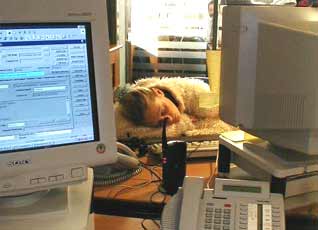
Know Your Health When In Your Office
Many people suffer health problems from work but few expect to get them from working in an office.
However thousands of people each year suffer office related injuries and disorders, which could be easily prevented with just a little care and preparation.
One of the most common causes of health problems in office workers is an incorrect posture while sitting at their desk, especially when they are using a computer. This can cause disorders affecting the back, neck, shoulders, arms, wrists, hands and fingers.If you are currently experiencing any discomfort whilst sitting at your desk you should seek advice from your Health and Safety representative or see your GP.
Your Chair
Your chair should be adjustable so that the height, back position and tilt of the chair can all be altered. The correct sitting position should be:
Sitting up straight with good back support (you can add support with a rolled up towel behind your back if necessary)
Knees should be level with your hips
Feet should be flat on the floor (a footrest can be used if feet are not on floor. Avoid crossing or twisting your legs as this can also cause problems)
The Computer
It is also important that your computer is position correctly to avoid discomfort.
The computer monitor should be positioned 12-30 inches from your eyes (an arms length is a good guide). The top of the screen should ideally be at eye level. The screen should be glare free, which may mean positioning it so that any sunlight or artificial lights do not reflect on your screen. If you are unable to find a suitable glare free position, anti glare screens are available that attach to the front of the monitor. Changes to the brightness and contrast of the screen can also help.
Eye Strain
Many people suffer eyestrain from working, or playing, on a computer for long periods of time.
Eyestrain means a sensation of tired eyes, which may be accompanied by increasing difficulty focussing or seeing, dryness, headache and general discomfort. Working at a computer screen or VDU greatly increases the risk of eye stain and may lead to Computer Vision Syndrome. For more information on this see: www.aoa.org/clincare/environmental-effects.asp.
It is very important therefore that you look after your eyes whilst at work.You can reduce the strain put on your eyes by:
Using the correct posture as described above
Use a document holder next to your screen so that your eyes do not need to keep refocusing
Adjust the controls on your monitor so that the brightness of the screen is comfortable
Use a style and size of font that is comfortable. Small fonts can cause your blood pressure and stress levels to rise
Light the screen from above or behind with a table lamp
Use an anti glare device
Use vases of flowers or damp plants in your work space to ensure that the air is not too dry (dry air attracts dust and irritates the eyes)
Take frequent short breaks allowing your eyes to rest and refocus (approx 5-10 minutes every hour)
Wherever possible swap to tasks which do not involve using the computer as often as possible.It is estimated that one in three people are working with sight defects that have never been diagnosed or are not properly corrected.
Get your eyes tested at least once per year and more often if you have any of these symptoms:
Problems seeing or reading
Blurred vision
Headaches
Dizziness
Pain in the Eyes
Watery Eyes
Dry eyes
By Macclesfield Borough Council
http://www.macclesfield.gov.uk/









